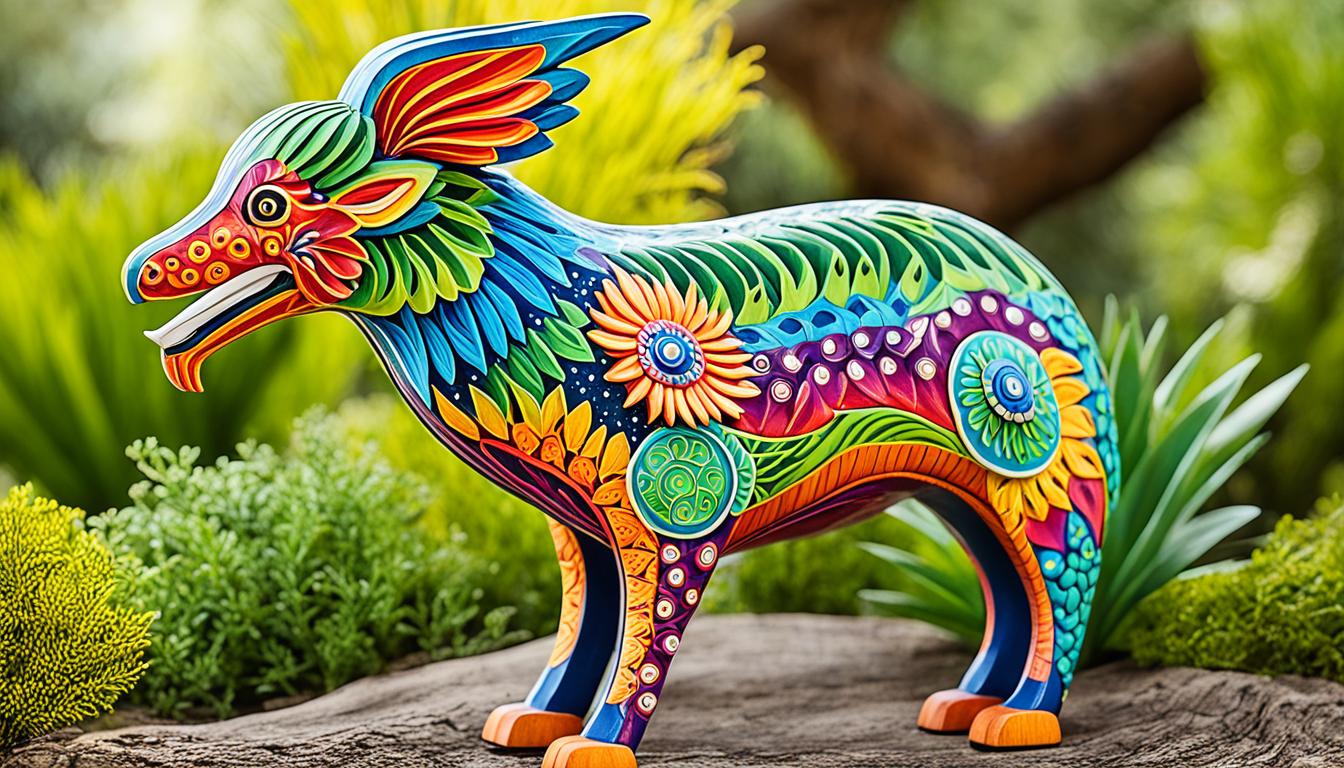Handcrafted Heritage: Discovering the Artisan Crafts of Oaxaca
Oaxaca, Mexico is famous for many things like its bright culture and tasty food. However, it’s also a hub for artisan crafts. These crafts, ranging from pottery to woodcarving, show off the region’s culture and the talents of its people.
Imagine strolling through Oaxaca City’s streets, where markets burst with colorful handmade goods. Each item reflects its maker’s story and creativity. But what is it that makes these crafts so special? We’re going to explore this question.
We invite you to discover Oaxaca’s varied and beautiful handicrafts. You’ll learn about the old techniques still in use today. These techniques have kept the region’s culture alive. From detailed pottery to lively woodcarvings, every craft has a story to tell.
Are you excited to learn about Oaxaca’s artisan crafts? Let’s get started and dive into this vibrant world!
Key Takeaways:
- Oaxaca is renowned for its diverse and beautiful handicrafts, including pottery, woodcarving, weaving, basketry, candle making, embroidery, and more.
- The craftsmanship in Oaxaca reflects the region’s rich cultural heritage and the unparalleled skills of local artisans.
- Many small towns and villages surrounding Oaxaca City specialize in specific crafts, some of which have been practiced since prehispanic times.
- The knowledge and techniques of these crafts are passed down through generations within Oaxacan families.
- Each piece of art produced in Oaxaca bears the personal touch of its creator, showcasing their individual creativity.
Pottery: Barro Negro and the Innovations of San Bartolo Coyotepec
The town of San Bartolo Coyotepec in Oaxaca is known for its eye-catching black pottery, called barro negro. This art has a long history and still draws people in with its elegance and skill.
Doña Rosa Real, a talented potter in the village, was the first to use this method. She found that firing pieces for less time made them turn pitch black. This big discovery changed Oaxaca’s pottery scene and helped local families keep their craft going.
The making of barro negro pottery is quite detailed. First, the clay is shaped on a wheel and dried in the sun. Then, it’s smoothed with a stone to get a shiny look. Finally, it’s cooked in special kilns to get that signature black color.
“Barro negro pottery is not only visually stunning but also represents the rich cultural heritage of Oaxaca and the remarkable skills of its artisans.” – [Artisan’s Name]
The shiny surface of barro negro pieces catches the light, showing off the hard work put into them. They often feature detailed designs that show Oaxacan culture and the natural world.
This pottery is mostly seen as art today. But, it reminds people of Oaxaca’s past uses of pottery, like holding food and water. When modern items like plastic became more popular, the need for practical pottery went down. So, artists started focusing on making beautiful art pieces.
San Bartolo Coyotepec: A Hub of Barro Negro Pottery
San Bartolo Coyotepec is famous for its barro negro pottery. Here, you can see artisans at work and buy their pieces in workshops and galleries.
The black pottery from this town is now known everywhere and loved by people who collect art. It shows off the creativity, skill, and importance of Oaxacan crafts.
Next, we’ll dive into another captivating craft from Oaxaca, woodcarving, and explore the fascinating world of alebrijes.
Woodcarving: Alebrijes and the Villages of San Martín Tilcajete, San Antonio Arrazola, and La Union Tejalapa
Oaxaca is famous for its woodcarving. A big part of this craft is alebrijes, brightly painted wooden animals. They symbolize the skill and creativity of Oaxaca.
The story of alebrijes starts in the 1930s. Pedro Linares of Mexico City made the first ones from paper mache. Manuel Jimenez from San Antonio Arrazola then turned these designs into wood carvings, starting a new art form. This style is unique and widely recognized today.
In the Oaxaca valley, three villages are known for their alebrijes. These are San Martín Tilcajete, San Antonio Arrazola, and La Union Tejalapa. Each village has its own style, showing the creativity of its people.
San Martín Tilcajete focuses on making fun and imaginative animals. They use bright colors and detailed patterns. Many creatures are from Oaxaca or myths.
San Antonio Arrazola is famous for its realistic carvings. The artists there create wood animals that look very real. They pay close attention to detail and how the animals look. Their work shows great skill and effort.
La Union Tejalapa is known for its big alebrijes. These are huge wooden sculptures that can be very tall. They amaze people with their size and detail. The village’s artists are experts in carving big pieces of wood into beautiful sculptures.
The woodcarvers also paint their alebrijes. They use bright colors and detailed designs. This makes their work even more eye-catching.
Visiting these villages is a great experience. You can see the artists at work, carving and painting. Talking to them gives you a better understanding of their art and culture.
Woodcarving in Oaxaca is not just an art form; it is an expression of the region’s rich cultural heritage and a testament to the remarkable talent of the local artisans.
It’s important to support these artists by buying their work. Your purchase helps keep this traditional craft alive and supports local communities. Plus, you get a unique piece of Oaxacan culture to take home with you.
Now, let’s take a closer look at some of the mesmerizing woodcarvings created by these talented artisans:
Woodcarving Masterpieces
| Woodcarving Village | Alebrije Example |
|---|---|
| San Martín Tilcajete | |
| San Antonio Arrazola |  |
| La Union Tejalapa |  |
Experiencing Oaxaca’s Crafts: Immersive Encounters and Supporting Local Artisans
One great way to appreciate Oaxaca’s crafts is by visiting the places they’re made. You get to meet the artisans, see where they live and work, and understand their art. Purchasing from these artisans helps their families and protects Oaxaca’s cultural legacy.
Buying from the artisans adds meaning to the item. It’s also a special souvenir from your time with an Oaxacan family. This way, you’re helping keep their craft and skills alive for the future. You’ll really see and feel Oaxaca’s beauty through these experiences.
So, if you want a unique gift or a beautiful piece for your home, check out Oaxaca’s crafts. Meet the artisans, listen to their tales, and back their hard work. Your experience with Oaxaca’s crafts will be memorable and aid the talented people behind these pieces.







